Favorite Radios for Linking
Standard disclamer. We don't know anything. Use this info at your own risk.
Tait TM8105 9600 baud capable
There is one model of Tait transceiver which we've had some success getting to pass 9600 G3RUH modem data.
Our notes are rather preliminary:
tm8105
Kenwood 1200 baud capable
Kenwood has several series of commercial land mobile radios which can be programmed for ham radio usage using a PC and readily available software and cables.
The total startup cost to be able to program the Kenwood radios is about $40 plus an appropriate computer.
All of the Kenwoods I've bought worked without internal tuning.
Adequate radios are available for under $50 including shipping if you are willing to watch eBay and wait.
I have created links to eBay searches which will show you radios.
See below.
- The radios I've selected are channelized, that is, they store the frequency at programming time and you select which channel to operate from a front panel knob or button.
Usually only the channel number is displayed.
- The naming conventions for the radios has changed over time but there are some consistent items.
- Radio numbers beginning with 6 are VHF Lo Band, meaning they were designed to work in the 30 to 50 megahertz range.
Some of these will work on 50Mhz ham radio.
- Radio numbers beginning with 7 are VHF Hi Band, meaning they were designed to work in frequencies above or below the 2-meter band.
Almost all of these work on 144Mhz to 148Mhz ham radio.
- Radio numbers beginning with 8 are UHF, meaning they were designed to work in frequencies above or below the 70-centimeter band.
Some of these work on 430Mhz to 450Mhz ham radio.
- Identifying which radios work in a ham band is part of the challenge, but not a huge part.
I'll get into that.
- narrow vs wide: All of the Kenwood land-mobile FM radios behave like we'd need them to in the ham band, i.e. same bandwidth, same modulation.
Some Kenwood radios are additionally capable of narrow bandwidth mode which will appear to be low audio when talking to a normal ham radio, but a narrow-set radio listening to wide-bandwidth audio will hear clipping and drop-outs.
Narrow bandwidth capable radios garner a higher price in the used market because they are still applicable to modern land-mobile operation.
Older radios are so-called wide-bandwidth and can no longer be used in some gov/commercial services in the US.
There is no particular benefit to having narrow-bandwidth mode for ham radio, however the radios which have narrow bandwidth tend to be the more modern radios.
There is a series of Kenwood radios which are normal FM (wide) but which have an after-manufacture modification to make them narrow.
This modification replaces components.
Those models are relabelled on the back to have an N or (N) at the end of the model number.
Stay away from those.
They are not optimal for packet (though if SUCH a deal? They DO work at 1200 baud, though possibly not as well).
- Models which have a G suffix are configurable for narrow or wide bandwidth operation.
G suffix radios are often configured using a MSWIndows computer and the software is compatible with
latest generation MSWindows computers.
- The H suffix indicates a higher power model.
What the H means depends on what a non-H radio is. 25 vs 40 watts, 45 vs 100 watts. It depends.
- A 2 suffix indicates there are fewer channels available than a 0 suffix.
TK760 is VHF 32 channel radio @ 25 watts. TK760H is the VHF 32 channel radio @ 40 watts
TK762 is VHF 2 channel model @ 25 watts. TK762H is the VHF 2 channel model @ 40 watts.
TK860G is UHF 128 channels @ 25 watts. TK860HG is 128 channels at 40 watts.
Tk862G is UHF 8 channels @ 25 watts. TK862HG is 8 channels at 40 watts.
- TK705d and TK805d are programmable from the faceplate if an internal jumper is set appropriately.
It is still channelized, but you don't ever need a PC.
You can still use a PC if you want to.
The other Kenwood radios all appear to need a PC.
There are rumors that the newer, more expensive models can also be face-plate programmed.
I haven't played with the newer models yet because the
cheaper older models serve as great packet links.
- TK860 and TK760 are available in 25 watt or in TK860H and TK760H 40 watt versions. These are 32 channel radios.
There are also TK862 and TK762 25 watt radios and TK862H and TK762H 40 watt radios. These are 2 channel radios.
There is a bandspread designation on the back plate. You want the -1 model.
If it is for sale on ebay, make sure the seller includes a photo of the back plate.
The -2 model covers frequencies which are too far from the ham band to be useful.
These radios are programmable using a MSDOS PC.
All of the -1 models are useful on packet as far as I know.
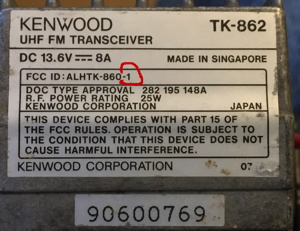
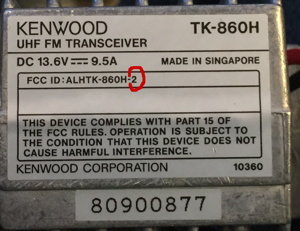
- TK862G and TK762G are available in 25 watt or in TK862HG and TK762HG 40 watt versions.
They are programmable using an MSWindows PC.
We think that there are -1 and -2 versions of these models.
See the -1 in the upper right of this label.
We believe that the -1 units are programmable for ham radio and while the -2 may be programmed for ham frequencies, it may be deaf, weak, or may fail to lock.
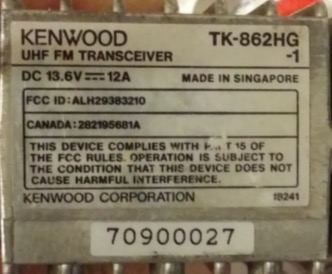
Thanks to ke6pjd for the photo
- Older Kenwood models must be programmed with an MSDOS computer, usually of low processor speed.
This is because there are timeouts in the Kenwood supplied software which are self-timed and do not use a real time clock.
The self-timed programs fail to talk to the mobile radio if the CPU on the PC is running faster than the programs were tested for.
A computer of under 300Mhz CPU speed seems to work.
- CHIRP software (after market) may also support these radios and not have the MSDOS and low speed requirement.
- The cables used to connect the PC to the radio (for programming the radio) depend on the model.
This document
describes the software needed and cables needed per model.
- The Repeater Builder Website has been extremely useful for figuring things out. If it is not here
and you needed to know it, I suggest you email to the TARPN groups-io email reflector, and try to figure it
out from repeater builder.
If you do work it out, please send me email at my QRZ-listed address so I can include your information.
If you don't figure it out, feel free to email to the TARPN groups-io email reflector,
or to me, and we'll see what we can do.
- Wiring TK to TNC-PI describes making a cable for radio to TNC.
|
Links to Ebay with searches for Kenwood radios
Note: All of these radio models key up and unkey quickly. TXDELAY settings of 15 usually work.
Kenwood TK760H,
Kenwood TK762H,
Kenwood TK805d,
Kenwood TK862G TK862H TK862HG,
We have wiring instructions under BUILDER (see lower right corner of the page) for making cables for these.
The photo to the right
shows an iPod on top of TK762H 40watt 2 channel radio, on top of another TK762H, on top of a TK760H 40 watt 32 channel radio, on top of a TK862G 25watt 8 channel radio
|
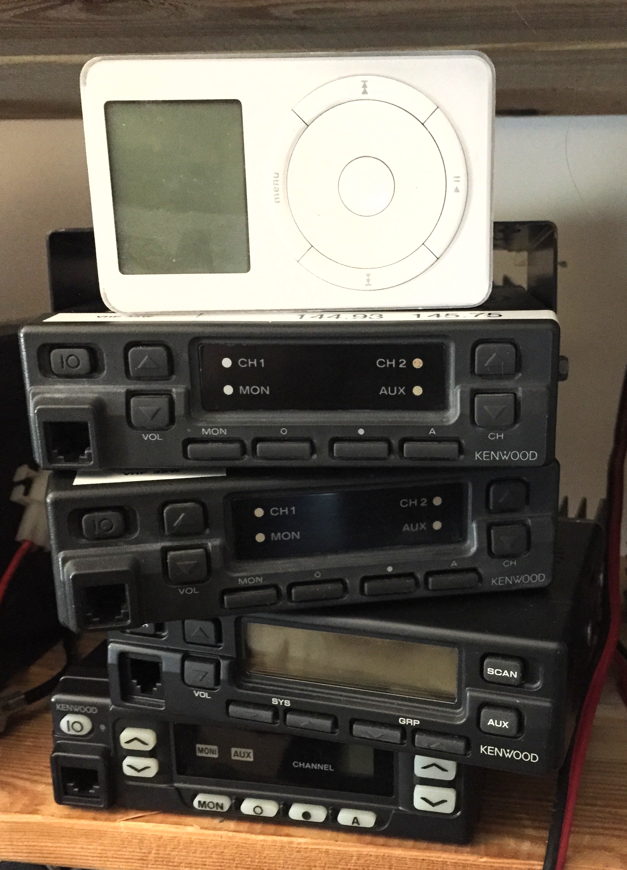
ipod shown for scale
|
Vertex 1200 baud capable
One model of Vertex has been very useful.
The Vertex FTL-1011 is a VHF lo-band radio that can be programmed to the 50Mhz ham band and delivers about 40 watts.
The FTL-1011 is available in 3 different sub-models.
They use different software to program them, although all of the software requires a slow MSDOS PC, 300Mhz or slower.
The FTL-1011 is pretty easy to align but alignment is often required.
They lose sensitivity above 51Mhz but they can be operated in the repeater subband.
They are excellent on the 50.9 to 51.0 packet range.
Check out
YO4HFU on Vertex. Contact the
TARPN groups-io email reflector for info.
See below for ebay search info.
These should be available for under $70 each including shipping, often as low as $35.
The Vertex FTL-2011 is a VHF hi-band radio.
I've never owned one but I understand it programs up the same way and is available in the same versions and uses the same mike cable.
The Vertex FTL-7011 is a UHF radio.
I have one and it works well at the top of the 440 band but has limits to how low it can be used without cracking open coils and making difficult adjustments.
TNC-PI and Vertex wiring instructions shows how to wire the TNC to the Vertex radio.
FTL-1011
The FTL-1011 is available in 3 different models, 4 channel, 12 channel, 99 channel.
They all have the same RF characteristics as far as I can tell and they tune the same way.
The biggest difference is the software required to program the radios, and the way the
channel is displayed.
The 4 channel model shows a light for each channel and is programmed with CE5 v3.0.
Later versions of CE5 will not let the radio be used in the ham bands. I don't know why.
The 99 channel radio is programmed with CE7.
I'm pretty sure all of the FTL-1011 radios will align into the 6m band.
I've bought about 30 of them and all but seven worked.
Five of the failure cases came from the same flea-market purchase.
One of the others had a bad final.
None worked without alignment.
Ebay link to search for FTL-1011 radios: Yeasu FTL-1011,
W4RFQ and KF4EZU can both tune the radios.
KE4VNC is working on a web page sequence for alignment.
Look for it here eventually.
|
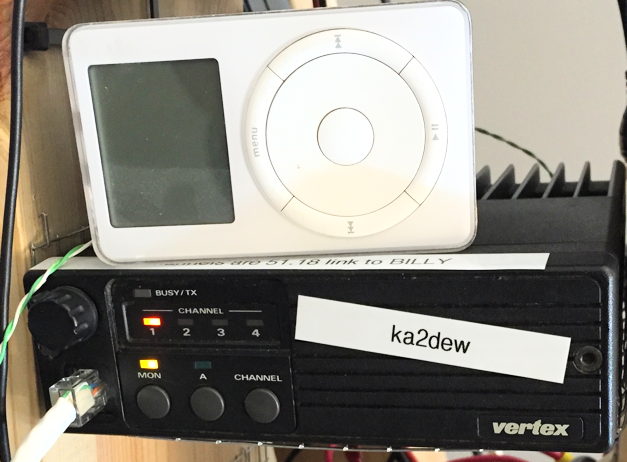
ipod shown for scale
|




